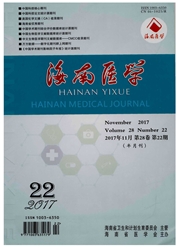

 中文摘要:
中文摘要:
目的:探讨IL-6抗体治疗小鼠变应性鼻炎的作用。方法:实验动物分三组:PBS组(正常对照组)、抗IL-6抗体组(以抗IL-6单克隆抗体处理)、Ig G抗体对照组(以Ig G对照抗体处理)。应用卵清蛋白(OVA)致敏建立小鼠变应性鼻炎模型,给予抗IL-6单克隆抗体干预,计量抗原激发后小鼠搔鼻数量。应用HE染色方法检测对小鼠鼻黏膜炎症影响,应用ELISA法检测小鼠灌洗液中IL-4、IFN-γ含量。结果:治疗后抗IL-6抗体组小鼠搔鼻症状相对于抗体对照组明显减轻(P〈0.01)。与PBS组比较,Ig G抗体对照组小鼠鼻腔灌洗液中总炎性细胞数,淋巴细胞数及嗜酸性粒细胞数明显升高(P〈0.05);IL-6抗体治疗后,小鼠鼻腔灌洗液中总炎性细胞数,淋巴细胞数及嗜酸性粒细胞数明显降低(P〈0.05);Ig G抗体对照组小鼠鼻腔灌洗液IL-4含量明显升高(P〈0.01),而IFN-γ含量不变(P〉0.05);IL-6抗体治疗后,IL-4含量较Ig G抗体对照组降低(P〈0.05),IFN-γ含量不变(P〉0.05)。结论:IL-6抗体可有效治疗小鼠变应性鼻炎。
 英文摘要:
英文摘要:
Objective: To explore the effect of anti-IL-6 in the treatment of allergic rhinitis in mice. Methods: A model of allergic rhinitis was established with Ovalbumin(OVA), and then the mice were treated with anti-IL-6 or Ig G control antibody. The nasal rubs were counted. HE staining was performed and the number of different inflammatory cells was counted in the nasal lavage. The content of IL-4 and IFN-γ were measured by ELISA. Results: Compared to PBS group(normal control group), the nasal rubs in the Ig G antibody control group was increased significantly(P〈0.01), but after the treatment of anti-IL-6, the nasal rubs was decreased(P〈0.01). Compared to PBS group, the total inflammatory cells, lymphoid cells and eosinophils showed significant difference for the Ig G antibody control group(P〈0.05), but after the anti-IL-6 treatment, the number of these cells were significantly decreased(P〈0.05). IFN-γ was not different among different groups(P〈0.05). But after the anti-IL-6 treatment, the IL-4 production was significantly decreased(P〈0.05).Conclusions: Anti-IL-6 treatment has therapeutic effect on the allergic rhinitis of mice.
 同期刊论文项目
同期刊论文项目
 同项目期刊论文
同项目期刊论文
 Resveratrol attenuates oxidative stress induced by balloon injury in therat carotid artery through a
Resveratrol attenuates oxidative stress induced by balloon injury in therat carotid artery through a Naringenin inhibits angiotensin II-induced vascular smooth muscle cellsproliferation and migration a
Naringenin inhibits angiotensin II-induced vascular smooth muscle cellsproliferation and migration a Resveratrol inhibits phenotypic switching of neointimal vascular smoothmuscle cells after balloon in
Resveratrol inhibits phenotypic switching of neointimal vascular smoothmuscle cells after balloon in 期刊信息
期刊信息
